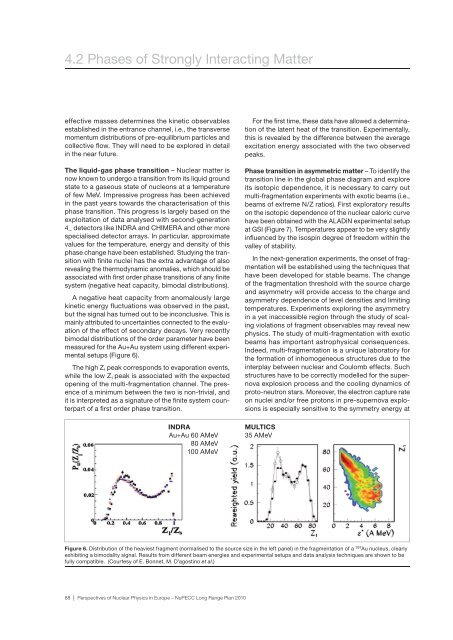Perspectives of Nuclear Physics in Europe - European Science ...
Perspectives of Nuclear Physics in Europe - European Science ...
Perspectives of Nuclear Physics in Europe - European Science ...
Create successful ePaper yourself
Turn your PDF publications into a flip-book with our unique Google optimized e-Paper software.
4.2 Phases <strong>of</strong> Strongly Interact<strong>in</strong>g Matter<br />
effective masses determ<strong>in</strong>es the k<strong>in</strong>etic observables<br />
established <strong>in</strong> the entrance channel, i.e., the transverse<br />
momentum distributions <strong>of</strong> pre-equilibrium particles and<br />
collective flow. They will need to be explored <strong>in</strong> detail<br />
<strong>in</strong> the near future.<br />
The liquid-gas phase transition – <strong>Nuclear</strong> matter is<br />
now known to undergo a transition from its liquid ground<br />
state to a gaseous state <strong>of</strong> nucleons at a temperature<br />
<strong>of</strong> few MeV. Impressive progress has been achieved<br />
<strong>in</strong> the past years towards the characterisation <strong>of</strong> this<br />
phase transition. This progress is largely based on the<br />
exploitation <strong>of</strong> data analysed with second-generation<br />
4 detectors like INDRA and CHIMERA and other more<br />
specialised detector arrays. In particular, approximate<br />
values for the temperature, energy and density <strong>of</strong> this<br />
phase change have been established. Study<strong>in</strong>g the transition<br />
with f<strong>in</strong>ite nuclei has the extra advantage <strong>of</strong> also<br />
reveal<strong>in</strong>g the thermodynamic anomalies, which should be<br />
associated with first order phase transitions <strong>of</strong> any f<strong>in</strong>ite<br />
system (negative heat capacity, bimodal distributions).<br />
A negative heat capacity from anomalously large<br />
k<strong>in</strong>etic energy fluctuations was observed <strong>in</strong> the past,<br />
but the signal has turned out to be <strong>in</strong>conclusive. This is<br />
ma<strong>in</strong>ly attributed to uncerta<strong>in</strong>ties connected to the evaluation<br />
<strong>of</strong> the effect <strong>of</strong> secondary decays. Very recently<br />
bimodal distributions <strong>of</strong> the order parameter have been<br />
measured for the Au+Au system us<strong>in</strong>g different experimental<br />
setups (Figure 6).<br />
The high Z 1 peak corresponds to evaporation events,<br />
while the low Z 1 peak is associated with the expected<br />
open<strong>in</strong>g <strong>of</strong> the multi-fragmentation channel. The presence<br />
<strong>of</strong> a m<strong>in</strong>imum between the two is non-trivial, and<br />
it is <strong>in</strong>terpreted as a signature <strong>of</strong> the f<strong>in</strong>ite system counterpart<br />
<strong>of</strong> a first order phase transition.<br />
INDRA<br />
Au+Au 60 AMeV<br />
80 AMeV<br />
100 AMeV<br />
For the first time, these data have allowed a determ<strong>in</strong>ation<br />
<strong>of</strong> the latent heat <strong>of</strong> the transition. Experimentally,<br />
this is revealed by the difference between the average<br />
excitation energy associated with the two observed<br />
peaks.<br />
Phase transition <strong>in</strong> asymmetric matter – To identify the<br />
transition l<strong>in</strong>e <strong>in</strong> the global phase diagram and explore<br />
its isotopic dependence, it is necessary to carry out<br />
multi-fragmentation experiments with exotic beams (i.e.,<br />
beams <strong>of</strong> extreme N/Z ratios). First exploratory results<br />
on the isotopic dependence <strong>of</strong> the nuclear caloric curve<br />
have been obta<strong>in</strong>ed with the ALADiN experimental setup<br />
at GSI (Figure 7). Temperatures appear to be very slightly<br />
<strong>in</strong>fluenced by the isosp<strong>in</strong> degree <strong>of</strong> freedom with<strong>in</strong> the<br />
valley <strong>of</strong> stability.<br />
In the next-generation experiments, the onset <strong>of</strong> fragmentation<br />
will be established us<strong>in</strong>g the techniques that<br />
have been developed for stable beams. The change<br />
<strong>of</strong> the fragmentation threshold with the source charge<br />
and asymmetry will provide access to the charge and<br />
asymmetry dependence <strong>of</strong> level densities and limit<strong>in</strong>g<br />
temperatures. Experiments explor<strong>in</strong>g the asymmetry<br />
<strong>in</strong> a yet <strong>in</strong>accessible region through the study <strong>of</strong> scal<strong>in</strong>g<br />
violations <strong>of</strong> fragment observables may reveal new<br />
physics. The study <strong>of</strong> multi-fragmentation with exotic<br />
beams has important astrophysical consequences.<br />
Indeed, multi-fragmentation is a unique laboratory for<br />
the formation <strong>of</strong> <strong>in</strong>homogeneous structures due to the<br />
<strong>in</strong>terplay between nuclear and Coulomb effects. Such<br />
structures have to be correctly modelled for the supernova<br />
explosion process and the cool<strong>in</strong>g dynamics <strong>of</strong><br />
proto-neutron stars. Moreover, the electron capture rate<br />
on nuclei and/or free protons <strong>in</strong> pre-supernova explosions<br />
is especially sensitive to the symmetry energy at<br />
MULTICS<br />
35 AMeV<br />
Figure 6. Distribution <strong>of</strong> the heaviest fragment (normalised to the source size <strong>in</strong> the left panel) <strong>in</strong> the fragmentation <strong>of</strong> a 197 Au nucleus, clearly<br />
exhibit<strong>in</strong>g a bimodality signal. Results from different beam energies and experimental setups and data analysis techniques are shown to be<br />
fully compatible. (Courtesy <strong>of</strong> E. Bonnet, M. D’agost<strong>in</strong>o et al.)<br />
88 | <strong>Perspectives</strong> <strong>of</strong> <strong>Nuclear</strong> <strong>Physics</strong> <strong>in</strong> <strong>Europe</strong> – NuPECC Long Range Plan 2010
















